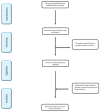Redox Balance in Male Infertility: Excellence through Moderation-"Μέτρον ἄριστον"
- PMID: 34679669
- PMCID: PMC8533291
- DOI: 10.3390/antiox10101534
Redox Balance in Male Infertility: Excellence through Moderation-"Μέτρον ἄριστον"
Abstract
Male infertility, a relatively common and multifactorial medical condition, affects approximately 15% of couples globally. Based on WHO estimates, a staggering 190 million people struggle with this health condition, and male factor is the sole or contributing factor in roughly 20-50% of these cases. Nowadays, urologists are confronted with a wide spectrum of conditions ranging from the typical infertile male to more complex cases of either unexplained or idiopathic male infertility, requiring a specific patient-tailored diagnostic approach and management. Strikingly enough, no identifiable cause in routine workup can be found in 30% to 50% of infertile males. The medical term male oxidative stress infertility (MOSI) was recently coined to describe infertile men with abnormal sperm parameters and oxidative stress (OS), including those previously classified as having idiopathic infertility. OS is a critical component of male infertility, entailing an imbalance between reactive oxygen species (ROS) and antioxidants. ROS abundance has been implicated in sperm abnormalities, while the exact impact on fertilization and pregnancy has long been a subject of considerable debate. In an attempt to counteract the deleterious effects of OS, urologists resorted to antioxidant supplementation. Mounting evidence indicates that indiscriminate consumption of antioxidants has led in some cases to sperm cell damage through a reductive-stress-induced state. The "antioxidant paradox", one of the biggest andrological challenges, remains a lurking danger that needs to be carefully avoided and thoroughly investigated. For that reason, oxidation-reduction potential (ORP) emerged as a viable ancillary tool to basic semen analysis, measuring the overall balance between oxidants and antioxidants (reductants). A novel biomarker, the Male infertility Oxidative System (MiOXSYS®), is a paradigm shift towards that goal, offering a quantification of OS via a quick, reliable, and reproducible measurement of the ORP. Moderation or "Μέτρον" according to the ancient Greeks is the key to successfully safeguarding redox balance, with MiOXSYS® earnestly claiming its position as a guarantor of homeostasis in the intracellular redox milieu. In the present paper, we aim to offer a narrative summary of evidence relevant to redox regulation in male reproduction, analyze the impact of OS and reductive stress on sperm function, and shed light on the "antioxidant paradox" phenomenon. Finally, we examine the most up-to-date scientific literature regarding ORP and its measurement by the recently developed MiOXSYS® assay.
Keywords: antioxidant capacity; antioxidants; male infertility; oxidative stress; reactive oxygen species; redox balance; reductive stress.
Conflict of interest statement
The authors declare no conflict of interest.
Figures



Similar articles
-
Male Oxidative Stress Infertility (MOSI): Proposed Terminology and Clinical Practice Guidelines for Management of Idiopathic Male Infertility.World J Mens Health. 2019 Sep;37(3):296-312. doi: 10.5534/wjmh.190055. Epub 2019 May 28. World J Mens Health. 2019. PMID: 31081299 Free PMC article. Review.
-
Oxido-Reduction Potential as a Method to Determine Oxidative Stress in Semen Samples.Int J Mol Sci. 2023 Jul 26;24(15):11981. doi: 10.3390/ijms241511981. Int J Mol Sci. 2023. PMID: 37569357 Free PMC article.
-
Oxidation-reduction potential as a new marker for oxidative stress: Correlation to male infertility.Investig Clin Urol. 2017 Nov;58(6):385-399. doi: 10.4111/icu.2017.58.6.385. Epub 2017 Nov 2. Investig Clin Urol. 2017. PMID: 29124237 Free PMC article. Review.
-
Oxidation-reduction potential of semen: what is its role in the treatment of male infertility?Ther Adv Urol. 2016 Oct;8(5):302-318. doi: 10.1177/1756287216652779. Epub 2016 Jun 28. Ther Adv Urol. 2016. PMID: 27695529 Free PMC article. Review.
-
A novel antioxidant formulation designed to treat male infertility associated with oxidative stress: promising preclinical evidence from animal models.Hum Reprod. 2016 Feb;31(2):252-62. doi: 10.1093/humrep/dev302. Epub 2016 Jan 4. Hum Reprod. 2016. PMID: 26732620
Cited by
-
Effect of surgical, medical, and behavioral weight loss on hormonal and sexual function in men: a contemporary narrative review.Ther Adv Urol. 2024 Sep 13;16:17562872241279648. doi: 10.1177/17562872241279648. eCollection 2024 Jan-Dec. Ther Adv Urol. 2024. PMID: 39285942 Free PMC article. Review.
-
On Males, Antioxidants and Infertility (MOXI): Certitudes, Uncertainties and Trends.Antioxidants (Basel). 2023 Aug 17;12(8):1626. doi: 10.3390/antiox12081626. Antioxidants (Basel). 2023. PMID: 37627621 Free PMC article. Review.
-
Experimental Evaluation of the Effectiveness of Isobornylphenols in the Model of Pathospermia and Their Effect on the Antioxidant-Prooxidant Balance of Male Germ Cells.Bull Exp Biol Med. 2022 Oct;173(6):714-718. doi: 10.1007/s10517-022-05618-9. Epub 2022 Nov 2. Bull Exp Biol Med. 2022. PMID: 36322303
-
Diagnostic value of oxidation-reduction potential for male infertility: a systematic review and meta-analysis.Transl Androl Urol. 2024 Jul 31;13(7):1228-1238. doi: 10.21037/tau-24-32. Epub 2024 Jul 16. Transl Androl Urol. 2024. PMID: 39100838 Free PMC article.
-
Correlation between viral infections in male semen and infertility: a literature review.Virol J. 2024 Jul 30;21(1):167. doi: 10.1186/s12985-024-02431-w. Virol J. 2024. PMID: 39080728 Free PMC article. Review.
References
-
- Dimitriadis F., Tsounapi P., Zachariou A., Kaltsas A., Sokolakis I., Hatzichristodoulou G., Symeonidis E.N., Kotsiris D., Gabales M.R., Vlachopoulou E., et al. Therapeutic effects of micronutrient supplements on sperm parameters: Fact or Fiction? Curr. Pharm. Des. 2021;27:2757–2769. doi: 10.2174/1381612826666200415173537. - DOI - PubMed
Publication types
LinkOut - more resources
Full Text Sources
Other Literature Sources

